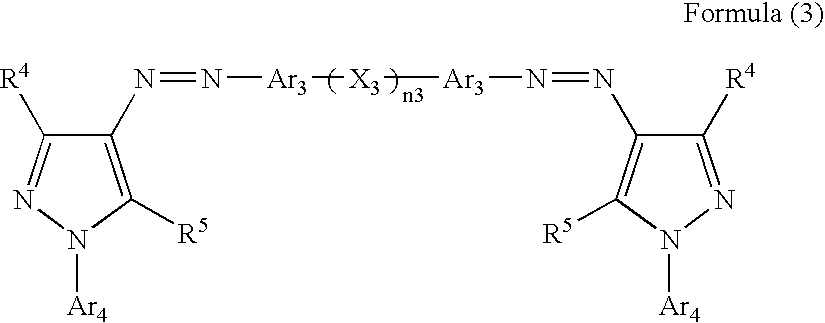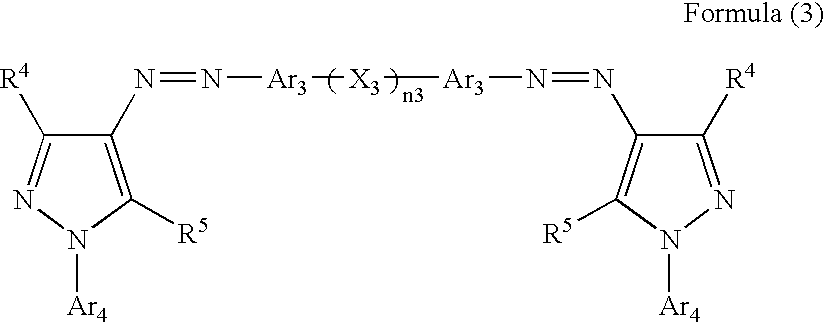Ink, ink-jet-recording method and bis-azo compound
a technology which is applied in the field of inkjet recording and compound, can solve the problems of light resistance, reduced transparency and a change in the hue of transmitted color, and difficulty in providing a dye that satisfies these requirements
- Summary
- Abstract
- Description
- Claims
- Application Information
AI Technical Summary
Benefits of technology
Problems solved by technology
Method used
Image
Examples
synthetic example 1
[0090]To 60 mL of an aqueous solution containing 2 g of sodium hydroxide, 17.2 g of Compound (a) was added, and further added 7 g of sodium nitrite. To a mixed solution of 35 mL of concentrated hydrochloric acid and 30 mL of water separately prepared, the above-prepared solution was added dropwise at a temperature of 5° C. or less. The resultant mixture was stirred for 30 minutes. Then, the resulting mixture was added dropwise into a mixed solution of 36 g of sodium sulfite and 150 mL of water at 10° C. or less. The resultant mixture was stirred for 1 hour at room temperature. Subsequently, 52 mL of concentrated hydrochloric acid was added thereto, and then the resulting mixture was stirred for 1 hour at 80° C. The thus-precipitated crystals were separated by filtration, to obtain 12.5 g of the Compound (b).
[0091]A solution of 5.7 g of (b), 5 g of pivaloylacetonitrile, 10 g of sodium hydrogencarbonate, 50 mL of water and 50 mL of ethanol was heated for 2 hours, and after adding 12 m...
synthetic example 2
[0094]To a mixed solution of 13.3 g of Compound (A) and 100 mL methanol, 10 g of 1,3-dibrompropane and 20 mL of an aqueous solution containing 4.5 g of sodium hydroxide were added, and the resultant mixture was heated under reflux for 2 hours. The thus-precipitated crystals were separated by filtration, to obtain 13 g of Compound (B).
[0095]A solution of 59.8 g of the Compound (C), 32 g of pivaloylacetonitrile, 65 g of sodium hydrogencarbonate, 340 mL of water, and 340 mL of ethanol was heated for 2 hours, and after adding 60 mL of hydrochloric acid thereto, the resulting mixture was further heated for 2 hours. Then, the thus-precipitated crystals were separated by filtration, to obtain 61 g of Compound (D).
[0096]A mixed solution of 6 g of the Compound (D), 80 mL of methanol, and 30 g of sodium acetate was cooled to 10° C. or less. Separately, using 3 g of Compound (B), a diazo solution was prepared. The diazo solution was added to the above mixed solution at 10° C. or less, and the ...
example 1
[0155]Deionized water was added to the following components, to make 1 liter in volume. Then, the resulting mixture was stirred for 1 hour under heating at 30 to 40° C. Thereafter, pH of the mixture was adjusted to 9 with 10 mol / L of KOH, and the obtained solution was vacuum filtered with a microfilter having an average pore diameter of 0.25 μm, to prepare a yellow ink solution.
[0156]
(Composition of ink solution A)Yellow dye 15 of this invention 5 gDiethylene glycol 20 gGlycerin 120 gDiethylene glycol monobutyl ether 230 g2-Pyrrolidone 80 gTriethanolamine17.9 gBenzotriazole0.06 gSURFYNOL TG (trade name) 8.5 gPROXEL XL2 (trade name, manufactured 1.8 gby Zeneca)
[0157]Ink solutions B and C were prepared in the same manner as in the preparation of the ink solution A, except that the dye was changed as shown in the following Table 3.
[0158]Separately, as ink solutions for comparison, ink solutions 101 and 102 were prepared in the same manner as in the preparation of the ink solution A,...
PUM
| Property | Measurement | Unit |
|---|---|---|
| temperature | aaaaa | aaaaa |
| temperature | aaaaa | aaaaa |
| mass % | aaaaa | aaaaa |
Abstract
Description
Claims
Application Information
 Login to View More
Login to View More - R&D
- Intellectual Property
- Life Sciences
- Materials
- Tech Scout
- Unparalleled Data Quality
- Higher Quality Content
- 60% Fewer Hallucinations
Browse by: Latest US Patents, China's latest patents, Technical Efficacy Thesaurus, Application Domain, Technology Topic, Popular Technical Reports.
© 2025 PatSnap. All rights reserved.Legal|Privacy policy|Modern Slavery Act Transparency Statement|Sitemap|About US| Contact US: help@patsnap.com



